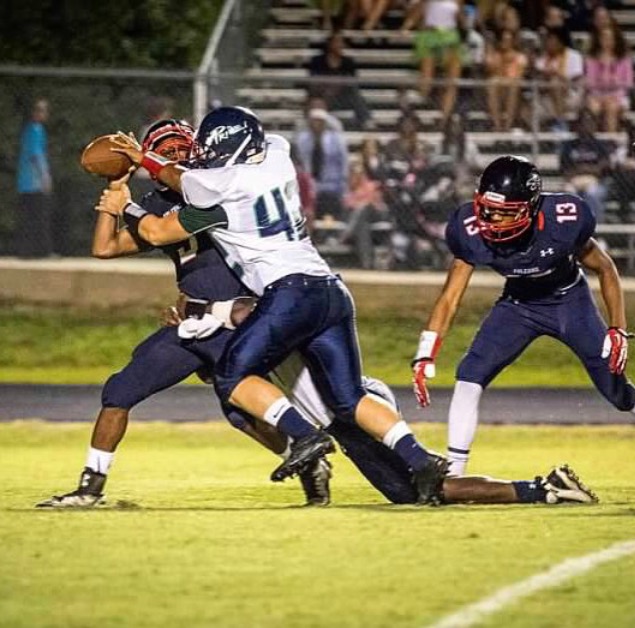Most athletes’ dream is to continue to play the sport they love until they can’t play anymore. Whether it’s to continue in college or to go pro, athletes always have their minds set on the future. But recent studies have shown that high school athletes are more vulnerable to concussions that could end their sports career early.
Concussions are caused by impact to the head, they can occur in many sports — not just high contact sports — although they are most prevalent in football. Recent studies have shown that the risk is much higher in high school players compared to professionals.
For high school football players, concussions are just a risk of playing the game. But with the modern technology used for college teams and the National Football League (NFL), the risk has been discovered to be much greater. Concussions are also prevalent in other sports such as soccer and volleyball.
“Dealing with something as serious as a concussion is important for us athletes to understand. I think that they are just risks of any sport,” said Natalie Young, Leesville volleyball player.
Concussions are a serious matter and should be taken with caution; lack of proper treatment can result in permanent brain damage or even death. The moments after being struck in the head are the most crucial.
Based on a study done by Frontline, high school football players, on average, are two times more likely for catastrophic injuries than college athletes. The study showed that there were 11.2 concussions for every 10,000 high school games. The rate for college athletes was 6.3 for every 10,000.
Many professionals are worried that student athletes will ignore signs of concussions because they are so dedicated to the game and their teammates.
That’s why Susan Ennis, the athletic trainer at Leesville, and other trained personnel are going the extra mile to help students to receive sufficient care once a concussion is obtained.
In order for students to participate in Wake County sports, they must complete a baseline test and fill out a form stating risk of not properly treating a concussion. Students must acknowledge any symptoms that could be a sign of a concussion.
“The baseline test that our students take is called the impact-test. It is a cognitive assessment given online to all student athletes. We use it as one tool that gives us a standard of the student’s normal cognitive ability,” said Ennis.
Concussions may seem unlikely, but three Leesville football players reported concussions in the 2015-2016 school year. “I’ve been teaching for 16 years, and there are way too many cases to count,” said Ennis.
Although recent studies have shown that properly fitted helmets can reduce the risk of concussions, there is no way to stop one from occurring. “There really isn’t a way to stop concussions from happening. High contact sports are just that, high contact. The only way to stop an athlete from getting a concussion is for them to not play at all,” said Ennis.
In soccer, contact with other athletes proves to result in a greater number of concussions than heading the ball. Although the rate of concussions is less than half of football, soccer players are still at risk.
According to the NCAA, Volleyball players are just as likely to get a concussion as any other sport and same with soccer. The risk that athlete take when the step out on the field , court or mat never lessens. Even the most experienced athletes can suffer from a concussion simply because there is no way to prevent a concussion 100%.
The Leesville athletic team is quick to help any athlete that has been struck in the head at either a game or practice. “If a student is hit, they are immediately evaluated by the adult staff,” said Ennis.
If a coach sees an athlete get hit in the head, they will ask the student athlete a few questions. “If the student shows any concussive symptoms, they are then taken out of the game and referred for a concussion, then they will be evaluation by a doctor,” said Ennis.
Several students obtained concussions throughout the football season just last year. “I was in a game and was hit in the head during kickoff. I missed two weeks of school — one and a half months of no tests and two months of no football or physical activity,” said Jack Walton, Leesville senior.
The school work alone can put a student athlete behind. “Concussions can impact a student athlete physically, mentally, emotionally and even socially. The recovery time can be anywhere from two weeks to indefinitely — that’s a lot of consequences from one injury,” said Ennis.
Depending on treatment, recognition and the severity of the impact an athlete can be out of the sport they once played their whole life. “I no longer play football due to my concussion and other minor reasons. Sometimes the risk just isn’t worth it,” said Walton.
Every athlete takes the topic of concussions differently. Some feel that they don’t need to worry about them because they are aware of the possibility and others are cautious when playing or practicing. “I’ve been playing volleyball for a long time and I’m fully aware of the possibility that I could get a concussion, but my love for the sport and the amount of fun I have while doing it makes the risk worth it,” said Young.

Leave a Reply